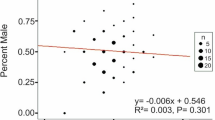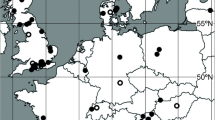Abstract
Experimental manipulations have revealed positive effects of litter reduction on offspring mass in small mammals, but little is known about this trade-off in large mammals. We examined the determinants of natural litter size variation and quantified the effects of litter size, maternal characteristics, and litter composition on yearling mass using 24 years of data on marked brown bears (Ursus arctos) in Sweden. Infanticide by adult males is a major cause of cub-of-the-year mortality, leading to litter size reductions. Litter size (n = 265) at den emergence ranged from one to four cubs (average, 2.7) and increased with maternal age. Litter size, however, appeared independent of maternal size, population density, interlitter interval, study area, or previous litter sex ratio. Yearling body mass increased with maternal body size but was independent of litter sex ratio. Litter size and yearling mass were negatively correlated, mostly because singletons were about 30 % heavier than yearlings from litters of two to four cubs. In reduced litters, survivors were on average 8 % heavier as yearlings than individuals from intact litters, suggesting that sibling competition reduces growth. Trade-offs between litter size and yearling mass in bears appear similar in magnitude to those found in small mammals.



Similar content being viewed by others
References
Agrell J, Wolff JO, Ylönen H (1998) Counter-strategies to infanticide in mammals: costs and consequences. Oikos 83:507–517
Bates D, Maechler M, Dai B (2008) lme4: Linear mixed-effects models using S4 classes. R package version 0.999375-37, http://lme4.r-forge.r-project.org/
Bellemain E, Swenson JE, Tallmon D, Brunberg S, Taberlet P (2005) Estimating population size of elusive animals with DNA from hunter-collected feces: four methods for brown bears. Conserv Biol 19:150–161
Bellemain E, Swenson JE, Taberlet P (2006) Mating strategies in relation to sexually selected infanticide in a non-social carnivore: the brown bear. Ethology 112:238–246
Bérubé CH, Festa-Bianchet M, Jorgenson JT (1996) Reproductive costs of sons and daughters in Rocky Mountain bighorn sheep. Behav Ecol 7:60–68
Bischof R, Fujita R, Zedrosser A, Söderberg A, Swenson JE (2008) Hunting patterns, ban on baiting, and harvest demographics of brown bears in Sweden. J Wildl Manag 72:79–88
Bischof R, Zedrosser A, Brunberg S, Swenson JE (2009) A note on opportunism and parsimony in data collection. J Wildl Manag 73:1021–1024
Bjärvall A (1990) The brown bear in Sweden. Aquilo Ser Zool 27:17–19
Campbell MT, Slade NA (1995) The effect of maternal mass on litter size and offspring survival in the hispid cotton rat (Sigmodon hispidus). Can J Zool 73:133–140
Carranza J (1996) Sexual selection for male body mass and the evolution of litter size in mammals. Am Nat 148:81–100
Clutton-Brock TH (1991) The evolution of parental care. Princeton University Press, Princeton
Clutton-Brock TH, Albon SD, Guinness FE (1981) Parental investment in male and female offspring in polygynous mammals. Nature 289:487–489
Clutton-Brock TH, Albon SD, Guinness FE (1985) Parental investment and sex differences in juvenile mortality in birds and mammals. Nature 313:131–133
Craighead JJ, Craighead FC, McCutchen HE (1970) Age determination of grizzly bears from fourth premolar tooth sections. J Wildl Manag 34:353–363
Crawley MJ (2007) The R Book. Wiley, West Sussex
Dahle B, Swenson JE (2003) Factors influencing length of maternal care in brown bears (Ursus arctos) and its effect on offspring. Behav Ecol Sociobiol 54:352–358
Dahle B, Zedrosser A, Swenson JE (2006) Correlates with body size and mass in yearling brown bears (Ursus arctos). J Zool 269:273–283
Derocher AE, Stirling I (1994) Age-specific reproductive performance of female polar bears (Ursus maritimus). J Zool 234:527–536
Derocher AE, Stirling I (1998) Maternal investment and factors affecting offspring size in polar bears (Ursus maritimus). J Zool 245:253–260
R Development Core Team (2010) R: a language and environment for statistical computing. R Foundation for Statistical Computing. http://www.R-project.org, Vienna, Austria
Dijkstra C, Bult A, Bijlsma S, Daan S, Meijer T, Zijlstra M (1990) Brood size manipulations in the kestrel (Falco tinnunculus): effects on offspring and parent survival. J Anim Ecol 59:269–285
Ericsson G, Wallin K, Ball JP, Broberg M (2001) Age-related reproductive effort and senescence in free-ranging moose, Alces alces. Ecology 82:1613–1620
Farley SD, Robbins CT (1995) Lactation, hibernation, and mass dynamics of American black bears and grizzly bears. Can J Zool 73:2216–2222
Festa-Bianchet M, King WJ (1991) Effects of litter size and population dynamics on juvenile and maternal survival in Columbian ground squirrels. J Anim Ecol 60:1077–1090
Fleming TH, Rauscher RJ (1978) On the evolution of litter size in Peromyscus leucopus. Evolution 32:45–55
Forchhammer MC, Clutton-Brock TH, Lindstrom J, Albon SD (2001) Climate and population density induce long-term cohort variation in a northern ungulate. J Anim Ecol 70:721–729
Gaillard J-M, Pontier D, Allainé D, Lebreton JD, Trouvilliez J, Clobert J (1989) An analysis of demographic tactics in birds and mammals. Oikos 56:59–76
Godfray HCJ, Parker GA (1991) Clutch size, fecundity and parent–offspring conflict. Phil Trans R Soc Lond B 332:67–79
Godfray HCJ, Partridge L, Harvey PH (1991) Clutch size. Annu Rev Ecol Syst 22:409–429
Hrdy SB (1977) Infanticide as a primate reproductive strategy. Am Sci 65:40–49
Humphries MM, Boutin S (2000) The determinants of optimal litter size in free-ranging red squirrels. Ecology 81:2867–2877
Jonsson P, Hartikainen T, Koskela E, Mappes T (2002) Determinants of reproductive success in voles: space use in relation to food and litter size manipulation. Evol Ecol 16:455–467
Kasparian K, Geibler E, Trillmich F (2005) Optimal offspring size in a small mammal: an exception to the tradeoff invariant life-history rule. Oikos 111:271–278
Kindberg J, Swenson JE (2006) Populationsberäkning av björnstammen i Sverige 2005 (Estimate of the bear population in Sweden in 2005). Report no. 2006-2. Scandinavian Brown Bear Research Project (in Swedish)
Koivula M, Koskela E, Mappes T, Oksanen TA (2003) Cost of reproduction in the wild: manipulation of reproductive effort in the bank vole. Ecology 84:398–405
Korpimäki E (1988) Costs of reproduction and success of manipulated broods under varying food conditions in Tengmalm’s owl. J Anim Ecol 57:1027–1039
Koskela E (1998) Offspring growth, survival and reproductive success in the bank vole: a litter size manipulation experiment. Oecologia 115:379–384
Koskela E, Jonsson P, Hartikainen T, Mappes T (1998) Limitation of reproductive success by food availability and litter size in the bank vole Clethrionomys glareolus. Proc R Soc Lond B 265:1129–1134
Krohne DT (1981) Intraspecific litter size variation in Microtus californicus: variation within populations. J Mammal 62:29–40
Mappes T, Koskela E, Ylönen H (1995) Reproductive costs and litter size in the bank vole. Proc R Soc Lond B 261:19–24
Mock DW, Parker GA (1997) The evolution of sibling rivalry. Oxford Univ. Press, Oxford
Morris DW (1998) State-dependent optimization of litter size. Oikos 83:518–528
Neuhaus P (2000) Weight comparisons and litter size manipulation in Columbian ground squirrels (Spermophilus columbianus) show evidence of costs of reproduction. Behav Ecol Sociobiol 48:75–83
Neuhaus P, Broussard DR, Murie JO, Dobson FS (2004) Age of primiparity and implications of early reproduction on life history in female Columbian ground squirrels. J Anim Ecol 73:36–43
Oksanen TA, Jokinen I, Koskela E, Mappes T, Vilpas H (2003) Manipulation of offspring number and size: benefits of large body size at birth depend upon the rearing environment. J Anim Ecol 72:321–330
Pasitschniak-Arts M (1993) Ursus arctos. Mamm Species 439:1–10
Pinheiro JC, Bates DM (2000) Mixed-effects models in S and S-PLUS. Springer, New York
Ramsay MA, Dunbrack RL (1986) Physiological constraints on life history phenomena: the example of small bear cubs at birth. Am Nat 127:735–743
Risch TS, Dobson FS, Murie JO (1995) Is mean litter size the most productive? A test in Columbian ground squirrels. Ecology 76:1643–1654
Rogers L (1976) Effects of mast and berry crop failure on survival, growth, and reproductive success of black bears. Trans N Am Wildl Nat Res 41:431–438
Roulin A, Ducrest A-L, Dijkstra C (1999) Effect of brood size manipulations on parents and offspring in the barn owl Tyto alba. Ardea 87:91–100
Saether BE, Swenson JE, Engen S, Bakke O, Sandegren F (1998) Assessing the viability of Scandinavian brown bear, Ursus arctos, populations: the effects of uncertain parameter estimates. Oikos 83:403–416
Samson C, Huot J (1995) Reproductive biology of female black bears in relation to body mass in early winter. J Mammal 76:68–77
Schwartz CC, Keating KA, Reynolds HV, Barnes VG Jr, Sellers RA, Swenson JE, Miller SD, McLellan BN, Keay J, McCann R, Gibeau M, Wakkinen WL, Mace RD, Kasworm WF, Smith R, Herrero S (2003) Reproductive maturation and senescence in the female brown bear. Ursus 14:109–119
Stearns SC (1992) The evolution of life histories. Oxford University Press, Oxford
Steyaert SMJG, Endrestol A, Hacklander K, Swenson JE, Zedrosser A (2012) The mating system of the brown bear Ursus arctos. Mammal Rev 42:12–34
Støen O-G, Zedrosser A, Wegge P, Swenson JE (2006) Socially induced delayed primiparity in brown bears Ursus arctos. Behav Ecol Sociobiol 61:1–8
Swenson JE (2003) Implications of sexually selected infanticide for the hunting of large carnivores. In: Festa-Bianchet M, Apollonio M (eds) Animal behavior and wildlife conservation. Island Press, Washington, pp 171–190
Swenson JE, Sandegren F, Soderberg A, Bjärvall A, Franzen R, Wabakken P (1997) Infanticide caused by hunting of male bears. Nature 386:450–451
Swenson JE, Dahle B, Sandegren F (2001a) Intraspecific predation in Scandinavian brown bears older than cubs-of-the-year. Ursus 12:81–92
Swenson JE, Sandegren F, Brunberg S, Sergerstrom P (2001b) Factors associated with loss of brown bear cubs in Sweden. Ursus 12:69–80
Williams GC (1957) Pleiotropy, natural selection, and the evolution of senescence. Evolution 11:398–491
Williams GC (1966) Natural selection, the cost of reproduction, and a refinement of Lack’s principle. Am Nat 100:687–690
Wilson AJ, Pemberton J, Pilkington JG, Clutton-Brock TH, Kruuk LEB (2009) Trading offspring size for number in a variable environment: selection on reproductive investment in female Soay sheep. J Anim Ecol 78:354–364
Zedrosser A, Dahle B, Swenson JE (2006) Population density and food conditions determine adult female body size in brown bears. J Mammal 87:510–518
Zedrosser A, Main E, Taberlet P, Swenson JE (2007a) Genetic estimates of annual reproductive success in male brown bears: the effects of body size, age, internal relatedness and population density. J Anim Ecol 76:368–375
Zedrosser A, Støen O-G, Sæbø S, Swenson JE (2007b) Should I stay or should I go? Natal dispersal in the brown bear. Anim Behav 74:369–376
Zedrosser A, Dahle B, Støen O-G, Swenson JE (2009) The effects of primiparity on reproductive performance in the brown bear. Oecologia 160:847–854
Acknowledgments
We thank the field personnel of the Scandinavian Brown Bear Research Project (SBBRP) for collecting data over the years. The SBBRP was funded by the Swedish Environmental Protection Agency, the Norwegian Directorate for Nature Management, the Swedish Association for Hunting and Wildlife Management, WWF Sweden, and the Research Council of Norway. M.F.B. and F.P. acknowledge the financial support of NSERC of Canada. F.P. is supported by the Canada Research Chair in Evolutionary Demography and Conservation. A.Z. was supported financially by the Norwegian Research Council. This is paper No. 129 from the Scandinavian Brown Bear Research Project.
Author information
Authors and Affiliations
Corresponding author
Additional information
Communicated by K. Ruckstuhl
Rights and permissions
About this article
Cite this article
Gonzalez, O., Zedrosser, A., Pelletier, F. et al. Litter reductions reveal a trade-off between offspring size and number in brown bears. Behav Ecol Sociobiol 66, 1025–1032 (2012). https://doi.org/10.1007/s00265-012-1350-3
Received:
Revised:
Accepted:
Published:
Issue Date:
DOI: https://doi.org/10.1007/s00265-012-1350-3




